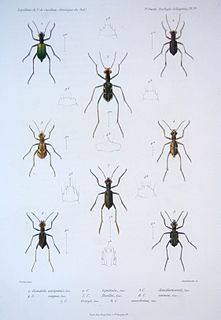Related Research Articles

Sir Aaron Klug was a Lithuanian-born British biophysicist and chemist. He was a winner of the 1982 Nobel Prize in Chemistry for his development of crystallographic electron microscopy and his structural elucidation of biologically important nucleic acid-protein complexes.

Pentacomia is a genus of beetles in the family Carabidae, containing the following species:

Velodona togata is a species of octopus in the monotypic genus Velodona. First described by Carl Chun in 1915, with a second subspecies discovered by Guy Coburn Robson in 1924, it was named for the distinctive membranes on its arms.
Agriloides is a genus of beetles in the family Buprestidae, containing the following species:
Omphra is a genus of beetles in the family Carabidae.
Ctenodactylinae is a subfamily of beetles in the family Carabidae.
Desera is a genus of beetles in the family Carabidae, containing the following species:

Lebiinae is a subfamily of beetles in the family Carabidae.
Acyphoderes is a genus of beetles in the family Cerambycidae, containing the following species:
Epimelitta is a genus of beetles in the family Cerambycidae, containing the following species:
Odontocera is a genus of beetles in the family Cerambycidae, containing the following species:
Ctenodes is a genus of beetles in the family Cerambycidae, containing the following species:

Epicauta is a genus of beetles in the blister beetle family, Meloidae. The genus was first scientifically described in 1834 by Pierre François Marie Auguste Dejean. Epicauta is distributed nearly worldwide, with species native to all continents except Australia and Antarctica. Surveys have found the genus to be particularly diverse in northern Arizona in the United States. Few species occur in the Arctic, with none farther north than the southern Northwest Territory of Canada.

Hemilophini is a tribe of longhorn beetles of the subfamily Lamiinae.
Compsosoma is a genus of longhorn beetles of the subfamily Lamiinae.
Apeba is a genus of longhorn beetles of the subfamily Lamiinae, containing the following species:
Icimauna ciliaris is a species of beetle in the family Cerambycidae. It was described by Johann Christoph Friedrich Klug in 1825. It is known from Argentina, Brazil and Paraguay.
Lycaneptia amicta is a species of beetle in the family Cerambycidae. It was described by Johann Christoph Friedrich Klug in 1825. It is known from Brazil.
Lycidola palliata is a species of beetle in the family Cerambycidae. It was described by Johann Christoph Friedrich Klug in 1825. It is known from Brazil.
Lycomimus ampliatus is a species of beetle in the family Cerambycidae. It was described by Johann Christoph Friedrich Klug in 1825. It is known from Brazil.
References
- ↑ "Apeba togata (Klug, 1825)". BioLib. Retrieved 8 September 2014.